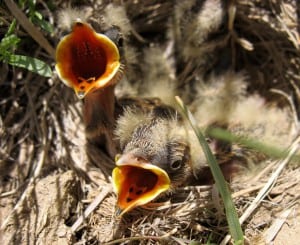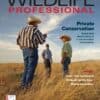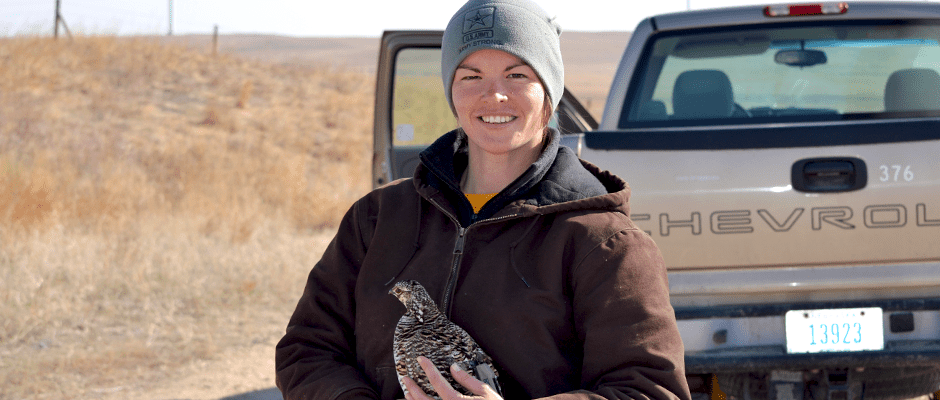Share this article
How prairie birds respond to wind turbines
While several studies have highlighted the direct impact of renewable energy infrastructure on North American birds — think birds colliding with turbines, for instance — researchers don’t know as much about its indirect effects on the region’s avian species including prairie birds.
In an effort to address that knowledge gap, researchers recently examined the reproductive success of horned larks (Eremophila alpestris) and McCown’s longspurs (Rhynchophanes mccownii) in Wyoming. The study was part of a special section in the journal The Condor: Ornithological Applications that also looked at the effects of oil and gas development in Alberta and the Northwest Territories on Canada’s boreal birds, the risk that wind towers in the Great Plains pose to wintering sandhill cranes (Grus canadensis), and the behavior of migrating raptors in response to power line construction.
When Wind Blows Through the Prairie

Horned lark chicks in their nest. Image courtesy of Anika Mahoney.
Horned larks and McCown’s longspurs both use short, sparse vegetation, however, other habitat preferences led researchers to believe that the birds potentially respond differently to wind energy development. While horned larks are often found along roadsides or agricultural lands, McCown’s longspurs choose sparse vegetation and habitat that’s less impacted by human activities.
One important similarity, however, is that populations of both species are declining across the U.S.
As part of the study, researchers examined the proximity of birds’ nests to wind turbines, the density of turbines in a given radius of each nest and the nests’ proximity to a developed habitat edge such as a road. They found that despite Horned Larks’ apparent tolerance to humans, the birds had less nesting productivity near higher densities of wind turbines, compared to McCown’s longspurs, which weren’t affected by turbine density.
“This is surprising, and we didn’t predict it,” said lead author Anika Mahoney, an ecologist with Lowham Walsh, LLC., who expected the Horned Larks to be more adaptable. “This really illustrates the need for more research into what’s going on at wind farms for a broad array of species.”
While studying the two species, Mahoney found the density of wind turbines was the best predictor of nest productivity. As a broader management strategy, Mahoney suggests building wind turbines in places that are already developed such as agricultural fields. Further, managers could help reduce scavengers by making sure human trash is collected and disposed of properly and collecting bird carcasses that were killed and left under turbines. Preventing rodents that can prey on nests from infesting turbines could also o help along with ensuring there are native plants in the areas the birds use.
Further Management Suggestions
As part of the special section, Jennifer Smith, a post-doctoral research associate at Virginia Polytechnic Institute and State University and lead editor of the section, along with her coauthor James Dwyer, an environmental scientist with EDM International, Inc., provide additional suggestions for management decisions regarding wind and solar energy development. For example, they suggest avoiding building infrastructure in areas with heavy bird use or where there are federally listed species or those of conservation concern. In addition to avoiding areas of high biodiversity, Smith recommends building conservation buffers as well as developing guidelines that provide ideal distances to install renewable energy infrastructures.
Mainly, Smith suggests that in addition to considering the direct impacts of renewable energy on wildlife when siting renewable energy facilities, managers should also consider indirect effects on, for example nesting success. “Ultimately, what we would like is for our results to inform siting guidelines so that any potential effects of future renewable energy facilities on birds are minimized,” she said.
Header Image: Smith conducts research on the effects of wind farms on greater prairie-chickens. ©Jocelyn Harrison








